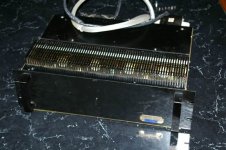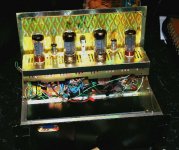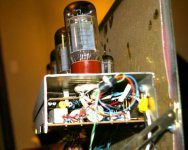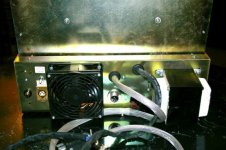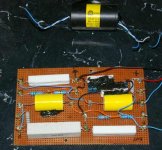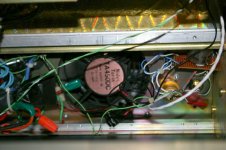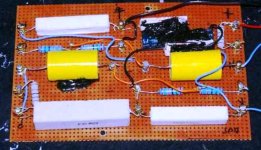To give a sense of what the physical build was like for this topology, I'm posting some photos of the original prototype for the studio-model we used at the 64 track studio as monitors.
This set of rack-mount monoblocks served also as the breadboard for the finalization of design specs
(and yes, we tried almost every topology including SRPP+ styles, and modifications on the taps, before settling on the Mu-Follower configuration, because of sound quality, the only object in this build)
The Redline Pro Rack-mount Series, serial #002L
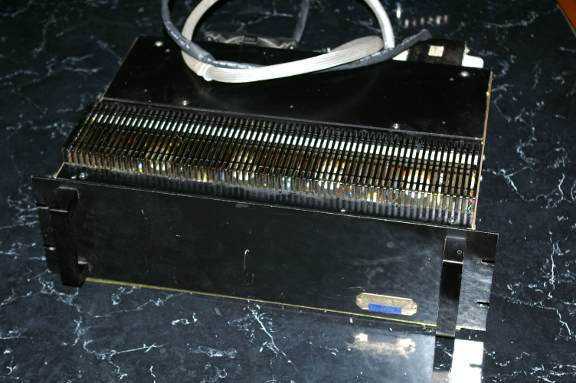
We chose rack-mount to integrate these power amps into the studio environment.
This entailed a separately housed powersupply, and heavy-duty cabling to protect sound techs.
The case allowed a quick-hinge to access tubes and do testing.
The amps were fully functional with the cases closed,
but the power tubes (sockets) must be oriented such that grid-sag cannot occur
when running full-tilt. Later versions of the amp reverted to upright positions,
because questions were raised regarding future reliability and standardization of available tubes.
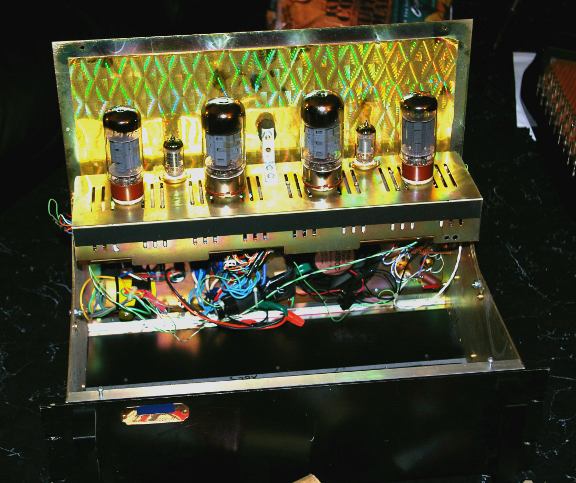
most of the wiring-harnesses below in the prototype were taken in and out multiple times,
so we weren't too concerned about final layout, but only easy point-testing etc.
The configuration shown (6550 / 6L6GC / 12AX7A) was an implementation
which delivered the right amount of power to compete with the MacKintosh's,
which at the time were the hands-down industry standard for mixdown.
Our amp blew the Mackintosh away in both power and clarity, quite a feat at the time,
although we weren't sure just how good our design was, until we A/B'ed it against the Bryston SS power amps, considered the cleanest high-power amps available commercially in the 90s.
here in the side-view, you can see the simple layout for the tube circuits,
consisting of perf-board units mounted close to the tubes.
It is important to realise that the two 12AX7s here are each running at different heater-voltage offsets, about 300 volts apart, and so each partial mini-board is a different set of components (i.e., amplifier and CCS top).
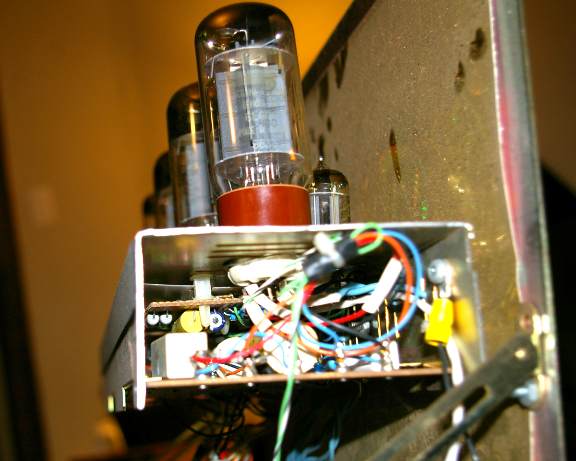
Another view of the simple layout for the power-stage is shown below:
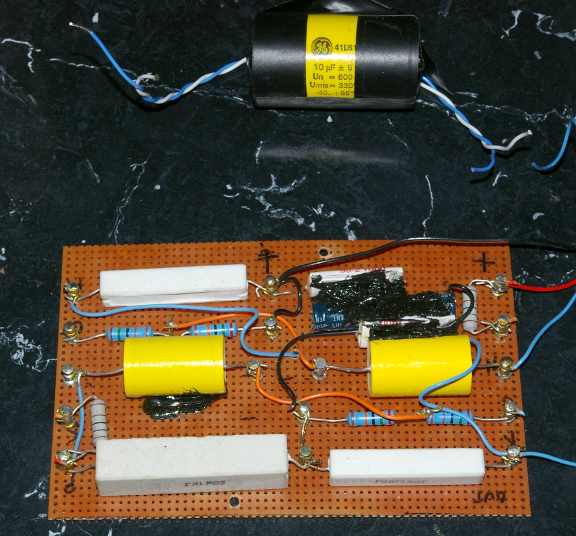
The reason you see some resistors end to end (besides for connecting),
is that standard resistors are only rated for about 300 volts, but in this circuit,
there could be transients 5 times that high. In key positions, after voltage-testing,
we sometimes made up a value by series, doubling the voltage rating, and power handling.
The signal caps were gooped to prevent vibrations in the signal-path.
The inside back panel held both the OT and the input circuitry, as well as a DC cooling fan.
This was added because in the studio environment, the amps were in a separate sealed room,
mounted alongside other devices (amps, board PSs for the Neves etc.).
The noise of the fan was small, and did not intrude into the circuit which was nearly impervious to hum or noise pickup.
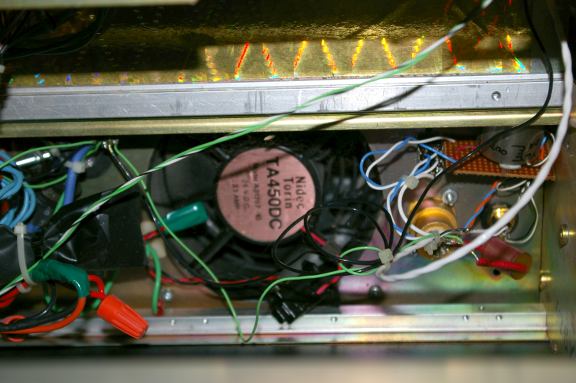
The use of the Jensen input transformer allowed a choice of balanced and unbalanced inputs,
allowing flexibility in application in studio situations.

The back of the panel shows the triple-insulated PS cabling, also protected by heat-shrink and cut-resistant plastic fibre tubing, which provides safety in the event of potential cable damage from door slamming, pulling, sharp edges in the rack etc.
All in all, these amps performed well above the Mackintoshes that they replaced,
creating a stunning staging clarity which was very useful for both recording and mixdown sessions.
Most of the engineers were shocked by the imaging,
which however was not always easy to reproduce on cheaper commercial units
which consumers were expected to be playing back the mixes on.
This forced us to use a variety of mixdown tests, so that we were not misled by the great sound,
as to what a mixdown was going to sound like in a real-world home or club environment.
For those purposes, mixdowns were also tested on Cerwin-Vega club gear, and typical home stereo units.
The idea of a 'near-field' standard was not yet solidified in the big studios at that time.
This set of rack-mount monoblocks served also as the breadboard for the finalization of design specs
(and yes, we tried almost every topology including SRPP+ styles, and modifications on the taps, before settling on the Mu-Follower configuration, because of sound quality, the only object in this build)
The Redline Pro Rack-mount Series, serial #002L

We chose rack-mount to integrate these power amps into the studio environment.
This entailed a separately housed powersupply, and heavy-duty cabling to protect sound techs.
The case allowed a quick-hinge to access tubes and do testing.
The amps were fully functional with the cases closed,
but the power tubes (sockets) must be oriented such that grid-sag cannot occur
when running full-tilt. Later versions of the amp reverted to upright positions,
because questions were raised regarding future reliability and standardization of available tubes.

most of the wiring-harnesses below in the prototype were taken in and out multiple times,
so we weren't too concerned about final layout, but only easy point-testing etc.
The configuration shown (6550 / 6L6GC / 12AX7A) was an implementation
which delivered the right amount of power to compete with the MacKintosh's,
which at the time were the hands-down industry standard for mixdown.
Our amp blew the Mackintosh away in both power and clarity, quite a feat at the time,
although we weren't sure just how good our design was, until we A/B'ed it against the Bryston SS power amps, considered the cleanest high-power amps available commercially in the 90s.
here in the side-view, you can see the simple layout for the tube circuits,
consisting of perf-board units mounted close to the tubes.
It is important to realise that the two 12AX7s here are each running at different heater-voltage offsets, about 300 volts apart, and so each partial mini-board is a different set of components (i.e., amplifier and CCS top).

Another view of the simple layout for the power-stage is shown below:

The reason you see some resistors end to end (besides for connecting),
is that standard resistors are only rated for about 300 volts, but in this circuit,
there could be transients 5 times that high. In key positions, after voltage-testing,
we sometimes made up a value by series, doubling the voltage rating, and power handling.
The signal caps were gooped to prevent vibrations in the signal-path.
The inside back panel held both the OT and the input circuitry, as well as a DC cooling fan.
This was added because in the studio environment, the amps were in a separate sealed room,
mounted alongside other devices (amps, board PSs for the Neves etc.).
The noise of the fan was small, and did not intrude into the circuit which was nearly impervious to hum or noise pickup.

The use of the Jensen input transformer allowed a choice of balanced and unbalanced inputs,
allowing flexibility in application in studio situations.

The back of the panel shows the triple-insulated PS cabling, also protected by heat-shrink and cut-resistant plastic fibre tubing, which provides safety in the event of potential cable damage from door slamming, pulling, sharp edges in the rack etc.
All in all, these amps performed well above the Mackintoshes that they replaced,
creating a stunning staging clarity which was very useful for both recording and mixdown sessions.
Most of the engineers were shocked by the imaging,
which however was not always easy to reproduce on cheaper commercial units
which consumers were expected to be playing back the mixes on.
This forced us to use a variety of mixdown tests, so that we were not misled by the great sound,
as to what a mixdown was going to sound like in a real-world home or club environment.
For those purposes, mixdowns were also tested on Cerwin-Vega club gear, and typical home stereo units.
The idea of a 'near-field' standard was not yet solidified in the big studios at that time.
Attachments
Last edited:
P.S., Tannoys were popular near-fields in the 90s,
but what near-fields an engineer preferred was kinda kept a proprietary trade-secret of sorts,
although speaker makers were touting their products quite loudly.
Totally depends on which Tannoy we're talking about. I assume the Golds; was it the stock Tannoy enclosure or the custom studio monitor one? Did you test with a variety of monitors or just the Tannoys?
My experience with studio monitors tells me that the lower impedance output amps almost always win in terms of overall sound accuracy and lack of fatigue. A typical 4-5 DF of a tube amp won't drive a lot of monitors well. So it's not surprising to me that you preferred the mu-follower, all other things being equal.
Another amp with a mirrored front. What's up with Canadians?
Empire Electron Amplifiers
Opps, on second look it just might be a shiny metal surface.
Empire Electron Amplifiers
Opps, on second look it just might be a shiny metal surface.
Another amp with a mirrored front. What's up with Canadians?
Empire Electron Amplifiers
Opps, on second look it just might be a shiny metal surface.
uh huh
never mind the totem pole... my amp has a stripper pole
Another amp with a mirrored front. What's up with Canadians?
Empire Electron Amplifiers
Opps, on second look it just might be a shiny metal surface.
Absolutely tasteless design, looks like rusty transformers painted.
Hot tubes close to black transformers and electrolytics, but mirrors on front panels.
Here is another approach:

Vented chassis, vented transformer compartment, capacitors underneath, mirrors behind tubes. Makes sense.
I agree with Wavebourn. I saw those amps several months ago and thought that they were designed by a middle schooler. For several thousand dollars, I would expect something better than painted sheetmetal. Wavebourn's design is both functional and aesthetically pleasing. Personally I can't stand shiny gold like alot of the Chinese amps, although bronze and copper can compliment wood nicely. Aluminum and stainless are better looking materials, monochromatic paint looks like someone covering up their mistakes or poor materials.
Another view of the simple layout for the power-stage is shown below:
Man - If someone knew how to solder properly it might have been even better!!!!
Attachments
Last edited:
Man - If someone knew how to solder properly it might have been even better!!!!
Don't laugh, it reminds me our daughter: when she learns something new in the school she lectures us, with proud aplomb. Especially she likes to teach medicine to her mom who is a doctor.
Don't laugh, it reminds me our daughter: when she learns something new in the school she lectures us, with proud aplomb. Especially she likes to teach medicine to her mom who is a doctor.
Eh - I'm an old QC weenie that wuz trained to solder to NASA specks. When I see solder joints like that I totally freak out.....
An externally hosted image should be here but it was not working when we last tested it.
You guys have obviously never seen the inside of a recording studio in the late 20th century.
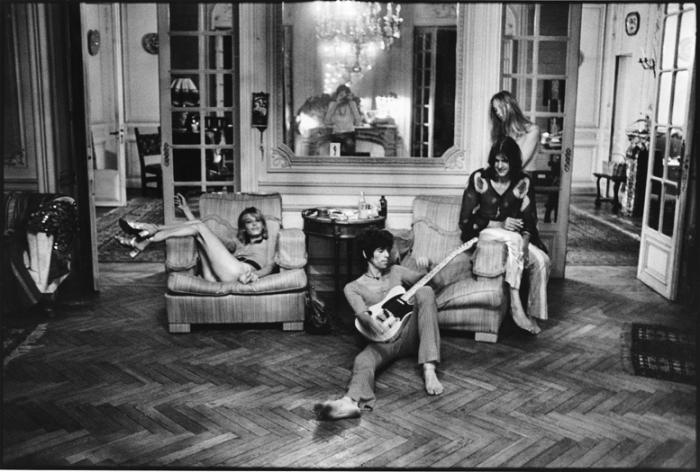
I remember one 'session' where the Stones booked a studio in the US for 3 weeks, put curtains up on every window, and jammed for 6-10 hrs at a time, hoping to catch 3 - 15 minutes of something they could make into a song. Keith Richards ordered several cases of Johnny Walker or some crap, while the rest chain-smoked reefers. It was impossible in that environment for the sound engineers to remain sober or straight, and not get fired.
An externally hosted image should be here but it was not working when we last tested it.
Same thing with Bruce Springsteen.

I'm surprised anyone could tell one end of an electrolytic from the other. I know I had to check 3 or 4 times everytime I tried to solder one in. And I was never sure how many times I actually checked, or if I had. The paranoia was so thick you could cut it with a cocaine-chopping razor.
Last edited:
My first soldering iron:
My dad bought it for me.
I must have built about 30 Radio-Shack projects using 741 op amps that never worked,
never suspecting that I was frying the chips with the 150 watt gun.
Eventually I learned that less is more with soldering irons.
How many fixable repairs did I destroy trying to do them with the wrong tools and no dexterity skills?
All I know is that there must be a long trail of disappointed customers who let me experiment with their stuff,
while I was on my learning-curve...
Eventually I began to successfully repair items occasionally,
then with moderate success.
Do you remember your first speaker re-cone?
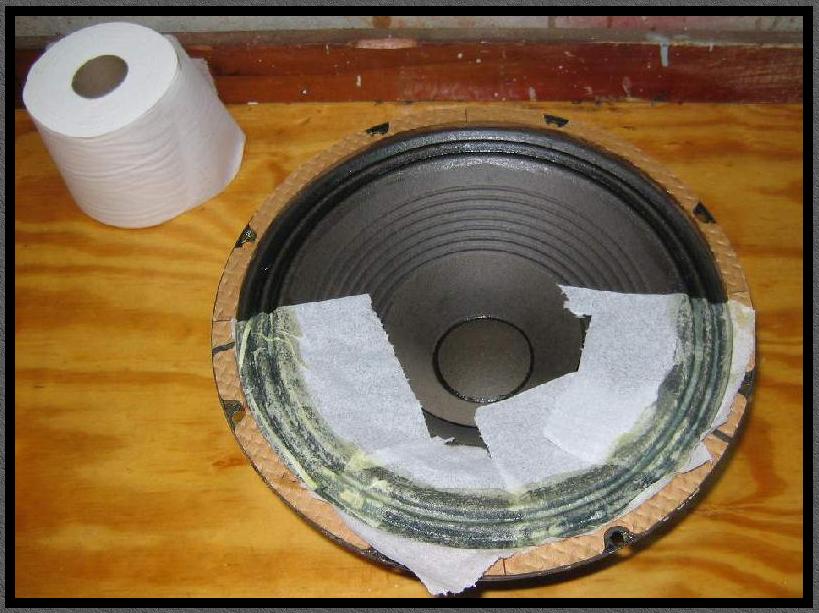
An externally hosted image should be here but it was not working when we last tested it.
My dad bought it for me.
I must have built about 30 Radio-Shack projects using 741 op amps that never worked,
never suspecting that I was frying the chips with the 150 watt gun.
Eventually I learned that less is more with soldering irons.
How many fixable repairs did I destroy trying to do them with the wrong tools and no dexterity skills?
All I know is that there must be a long trail of disappointed customers who let me experiment with their stuff,
while I was on my learning-curve...
Eventually I began to successfully repair items occasionally,
then with moderate success.
Do you remember your first speaker re-cone?

Do you remember your first speaker re-cone?
Fix'n the electronics stuff wuz not a problem - but my 1st speaker re-cone



uh huh
never mind the totem pole... my amp has a stripper pole
Don't laugh:
It was almost impossible to talk the investors out of gluing cutouts from Playboy and Pethouse all over the outside of most of the boxes.
People were always being extremely helpful with their design suggestions,
and would bring in pics of the Sunshine Girl with the bikinis erased out and hooters drawn in with a crayon.
"Can you make it look more like this?
So it matches my stage outfit. Thanks."
An externally hosted image should be here but it was not working when we last tested it.
My first soldering iron:
Not only do I remember it, I still have mine. No new tips, just a loop of #14 copper wire. Mostly used to solder up slot car chassis from brass tubing and piano wire.
Last night I was looking up tubes in the tube manual that I bought new in 1966. It still has most of the Lafayette Radio Electronics sticker on the front cover. LRE was two doors down from the slot car track. I spent a good deal of time in both places around age 12 to 15.
Hung out at a recording studio around age 17 or so. It was a third rate joint that made music demos and radio commercials. Wishbone Ash rehearsed there for the Argus album that was done at Criteria a few miles away. I used to sneak my cassette recorder in to catch the jam sessions.
I remember a discussion with the mixing guy at Criteria. He had several nice sets of speakers to listen to his mixes. He also had a piece of plywood with two 6 X 9 car speakers on it. I asked what that was for. He replied that a great deal of his music would be heard on an 8 track player in a car, and he wanted to hear his mix like the final listener would. He claimed that some music actually got a different mix for different delivery mediums.
I agree with Wavebourn. I saw those amps several months ago and thought that they were designed by a middle schooler. For several thousand dollars, I would expect something better than painted sheetmetal. Wavebourn's design is both functional and aesthetically pleasing. Personally I can't stand shiny gold like alot of the Chinese amps, although bronze and copper can compliment wood nicely. Aluminum and stainless are better looking materials, monochromatic paint looks like someone covering up their mistakes or poor materials.
You're forgetting that up here in Canada,
there were two simultaneous problems:
(1) No Parts. Whatever was in the bargain-bin at the electronics surplus store was what it was going to get built out of.
(2) 80% of Budget was blown on drugs. Funny how that happened, especially when the investors signed the checks.
"Here's a chunk of hash and a case of beer.
Let me know how things are going in a couple of hours."

...
I remember a discussion with the mixing guy at Criteria. He had several nice sets of speakers to listen to his mixes. He also had a piece of plywood with two 6 X 9 car speakers on it. I asked what that was for. He replied that a great deal of his music would be heard on an 8 track player in a car, and he wanted to hear his mix like the final listener would. He claimed that some music actually got a different mix for different delivery mediums.
Yep that sounds just about exactly what was going on at every studio I ever worked at!
Nobody believes me when I tell them that the Beatles used something like this:
An externally hosted image should be here but it was not working when we last tested it.
"Whats that thing?" "A tape recorder." "A what?"
"Can you make it look more like this?
So it matches my stage outfit. Thanks."
Sum people with to much $$$$ and a little short on brains often make some rather strange request. Some of them I could have not ever dreamed up on my own and I still wonder where in the

- Status
- Not open for further replies.
- Home
- Amplifiers
- Tubes / Valves
- Ju-Jutsu: The Ultimate Monoblock
